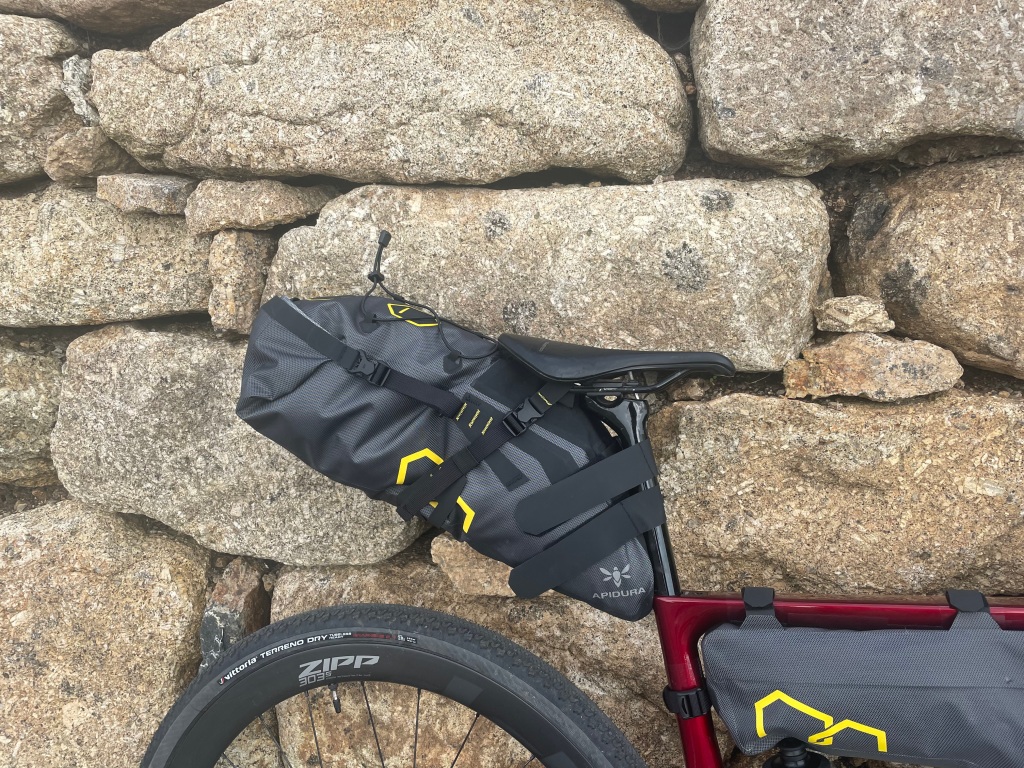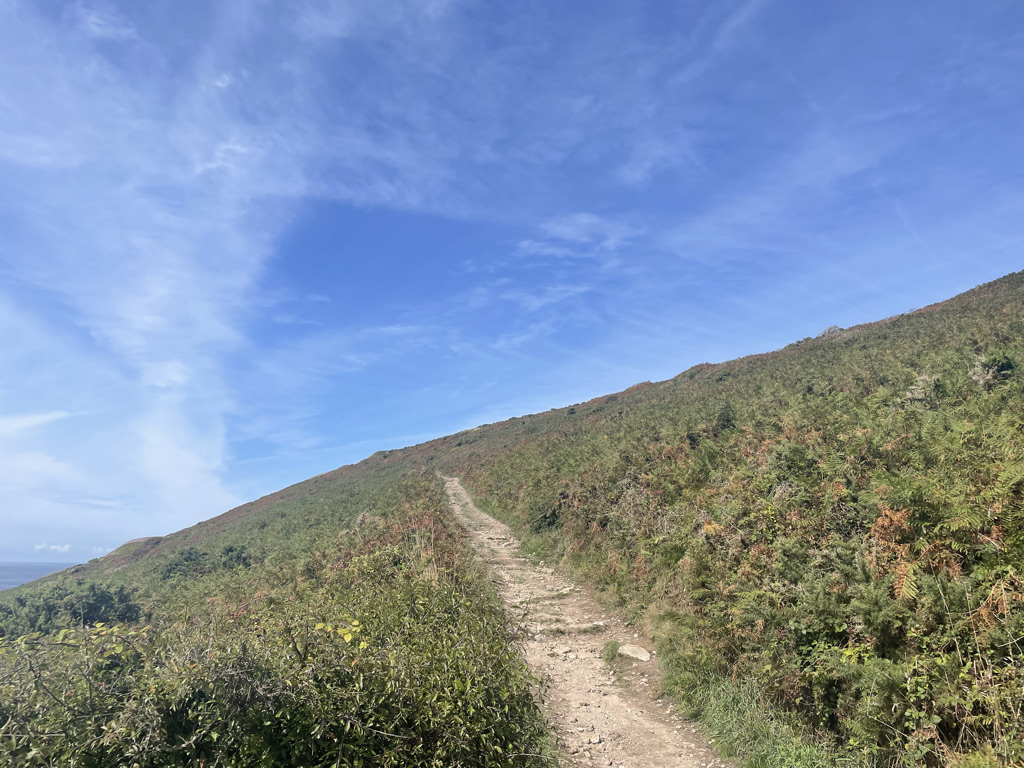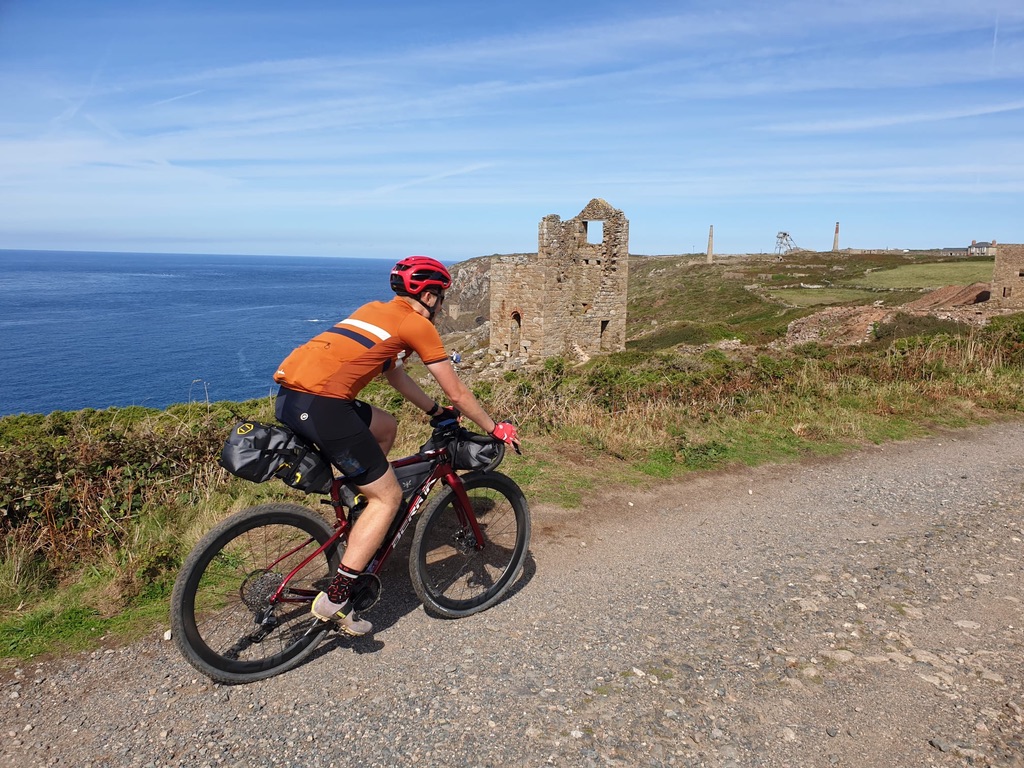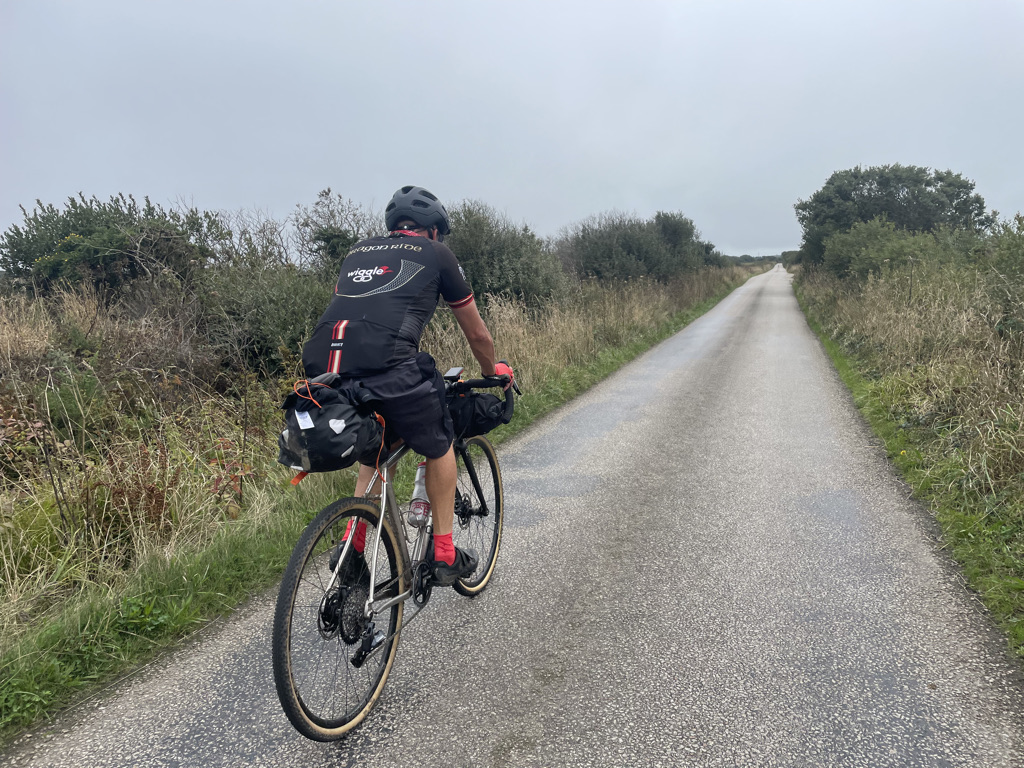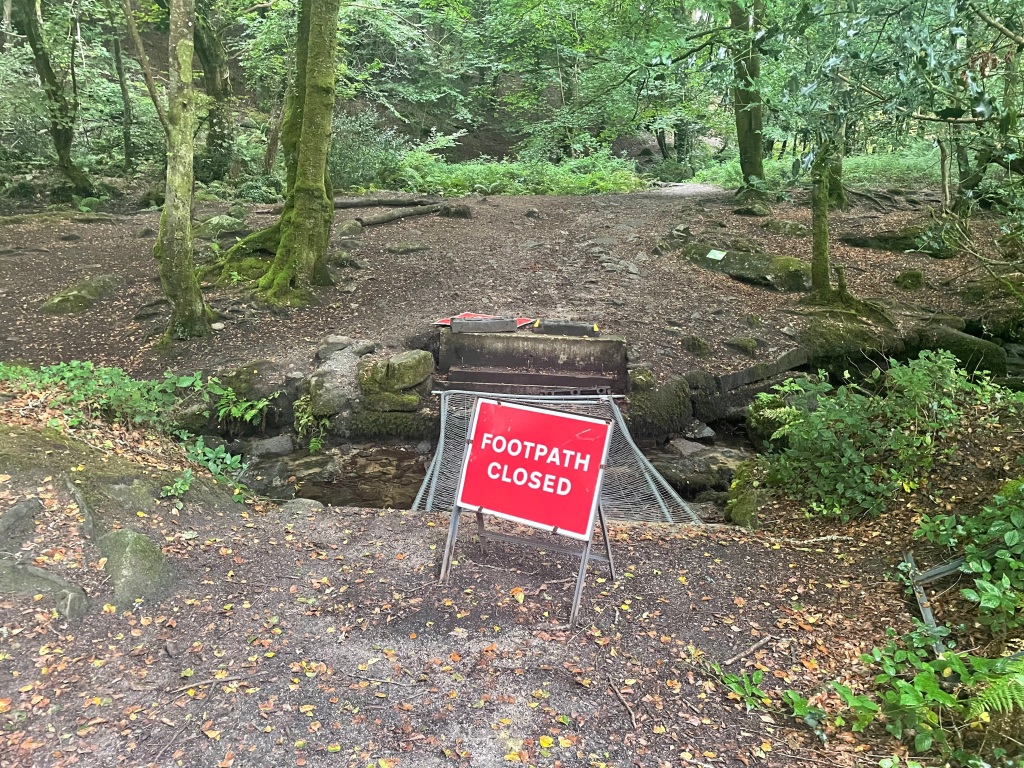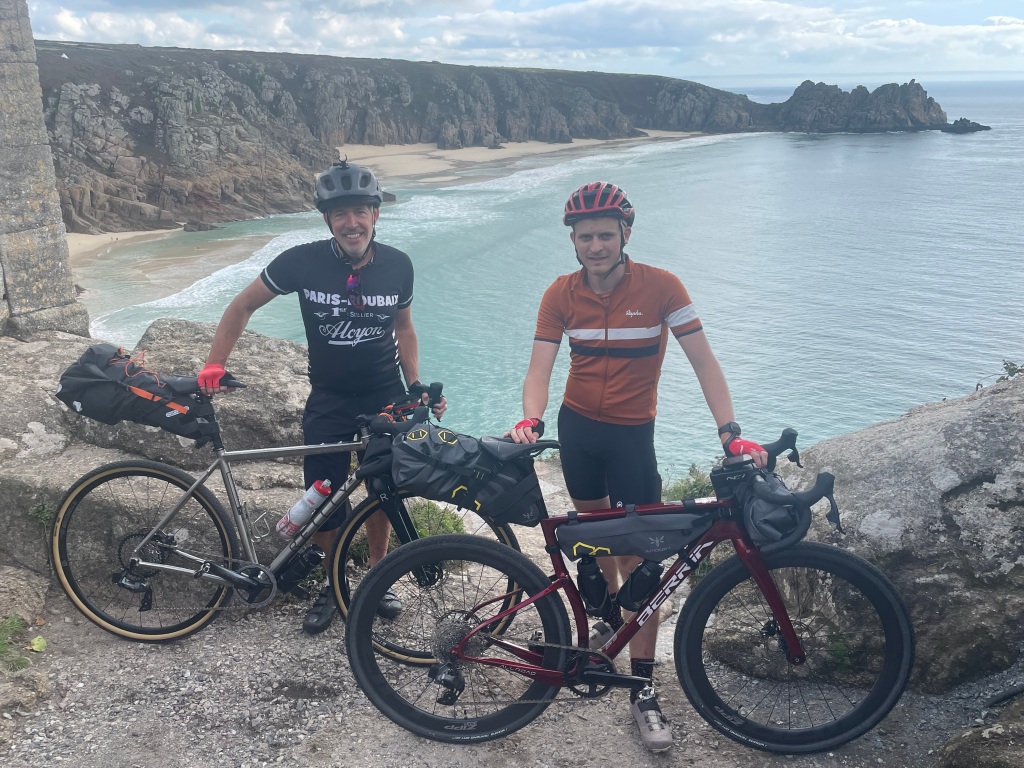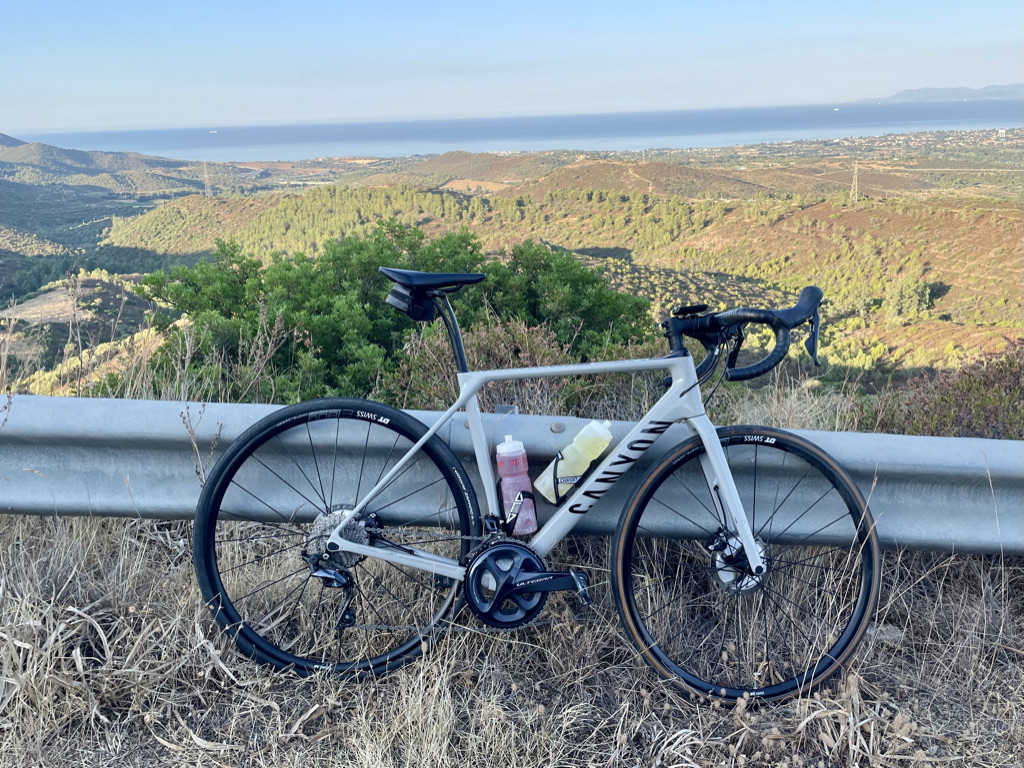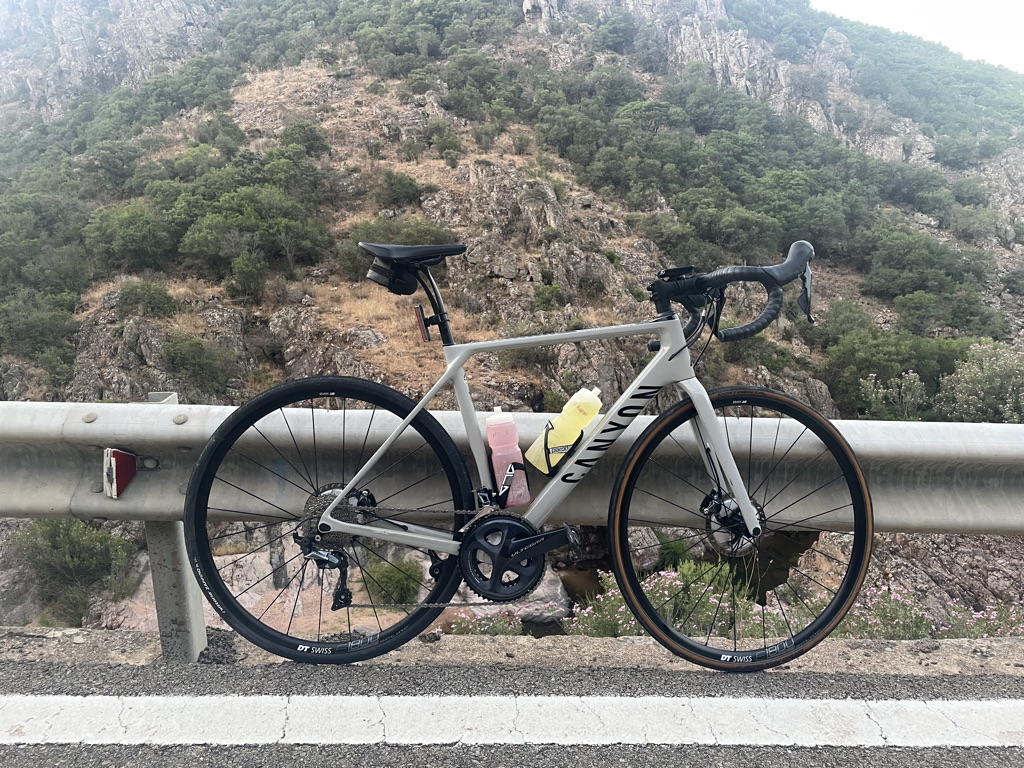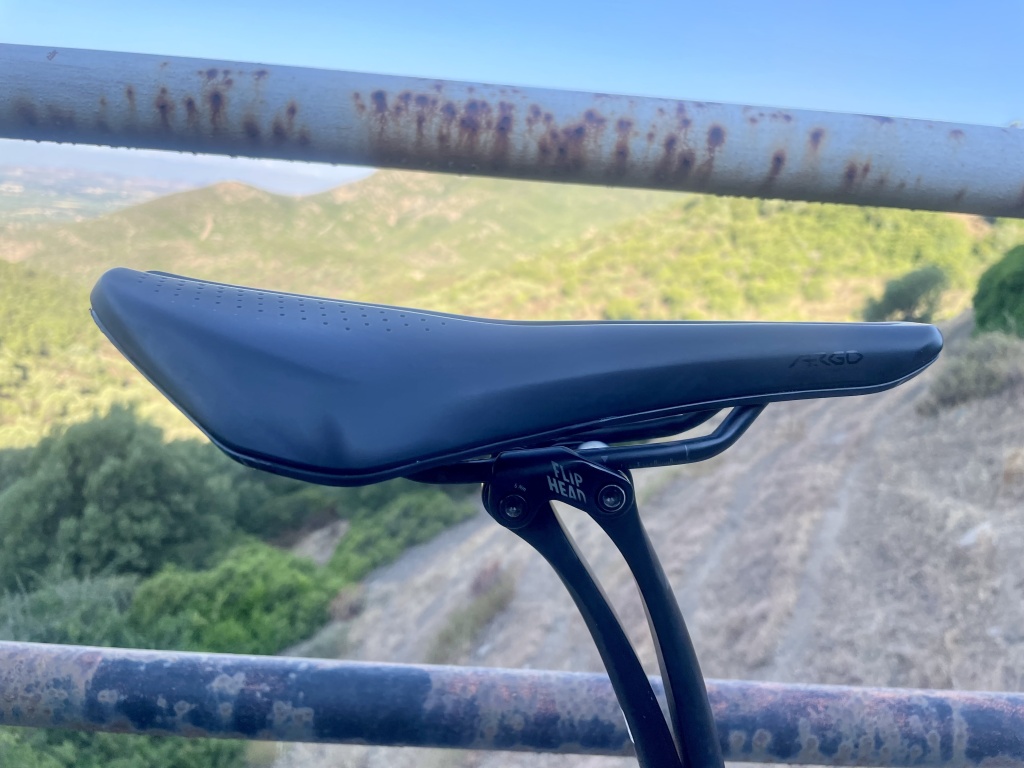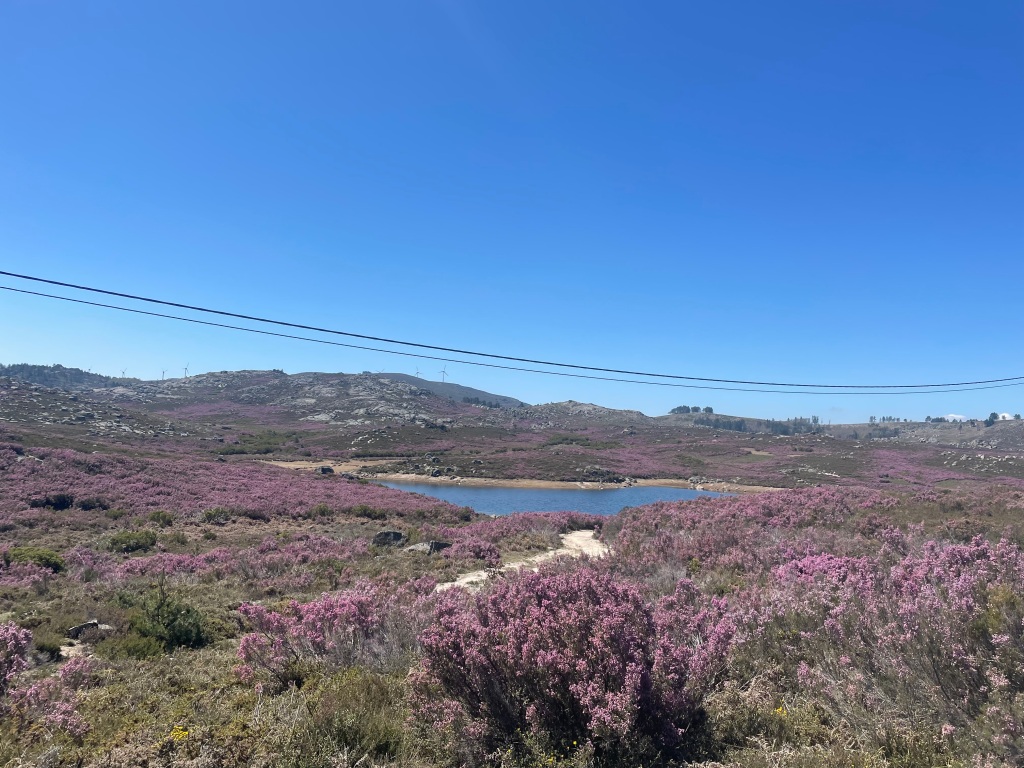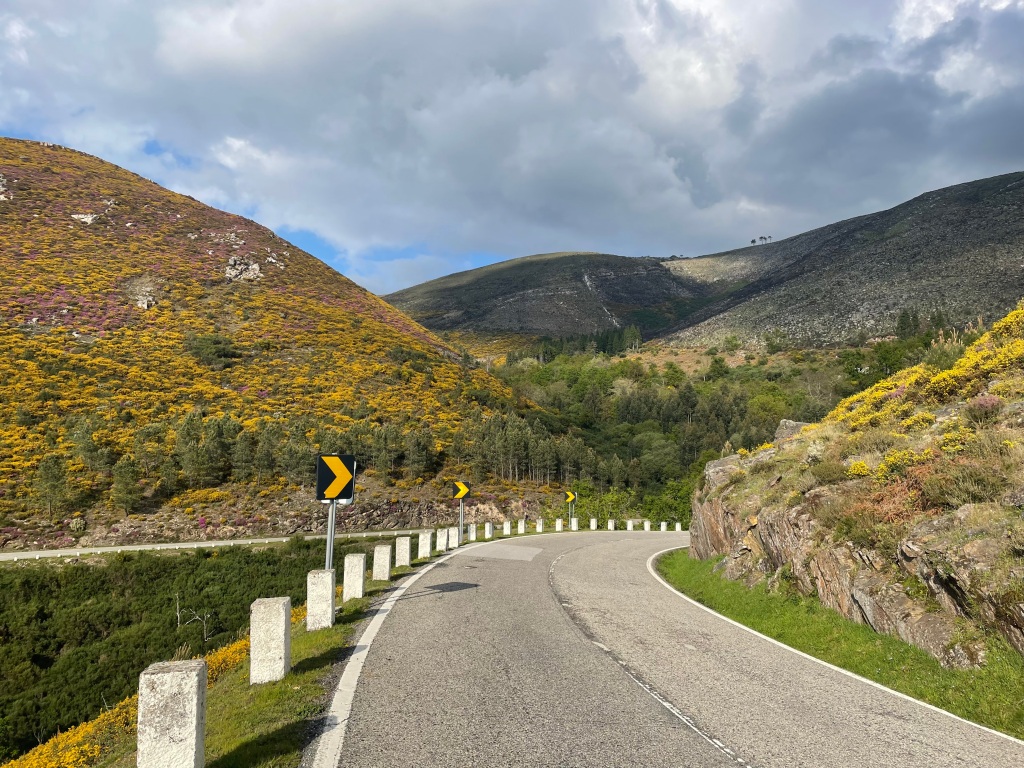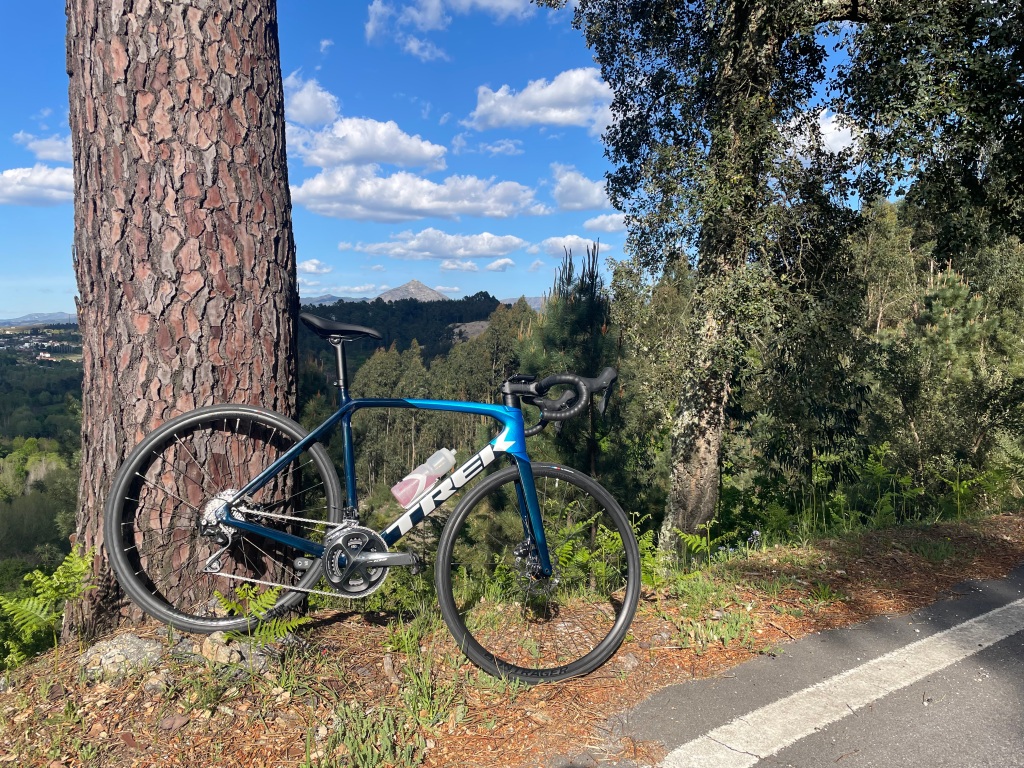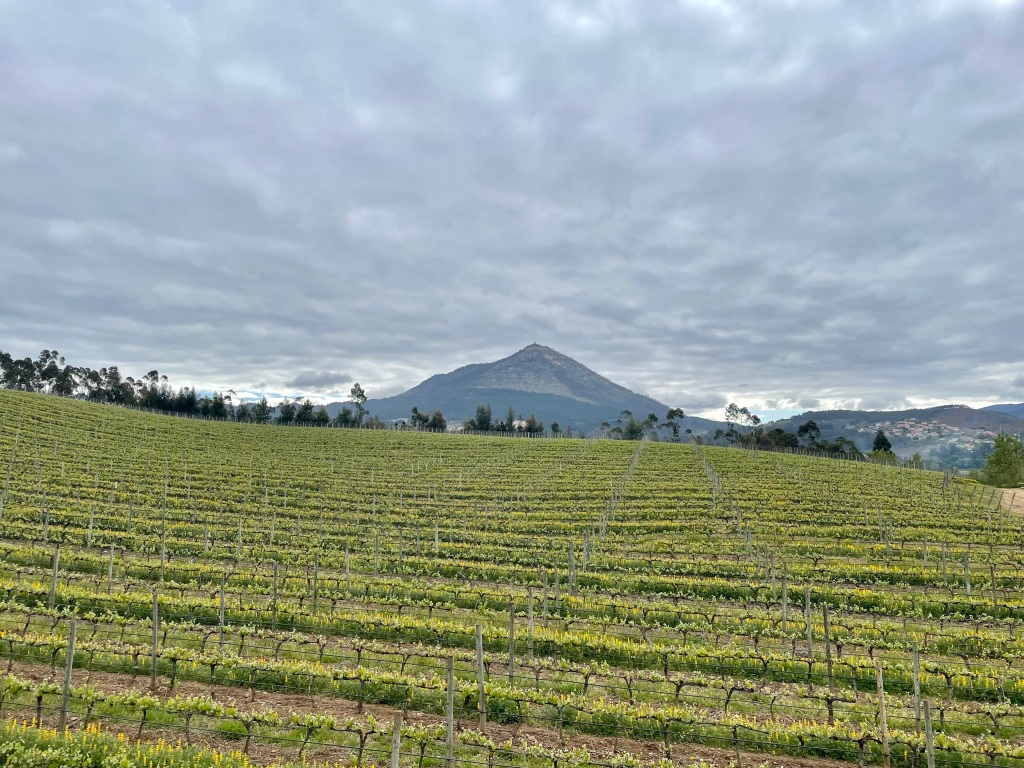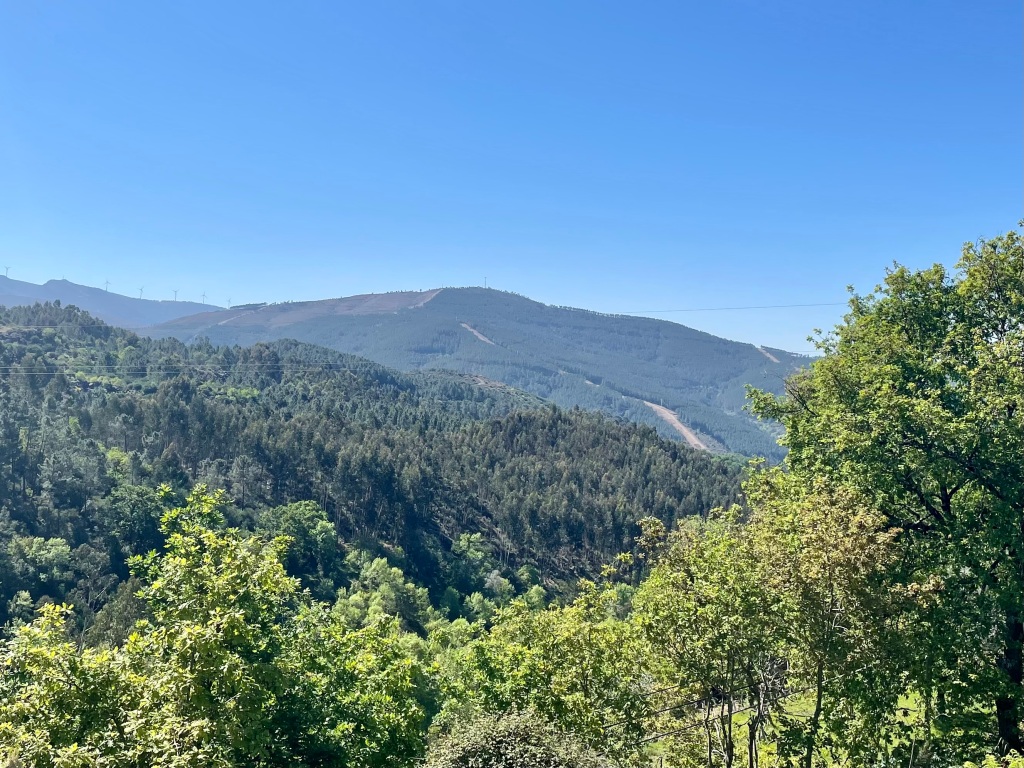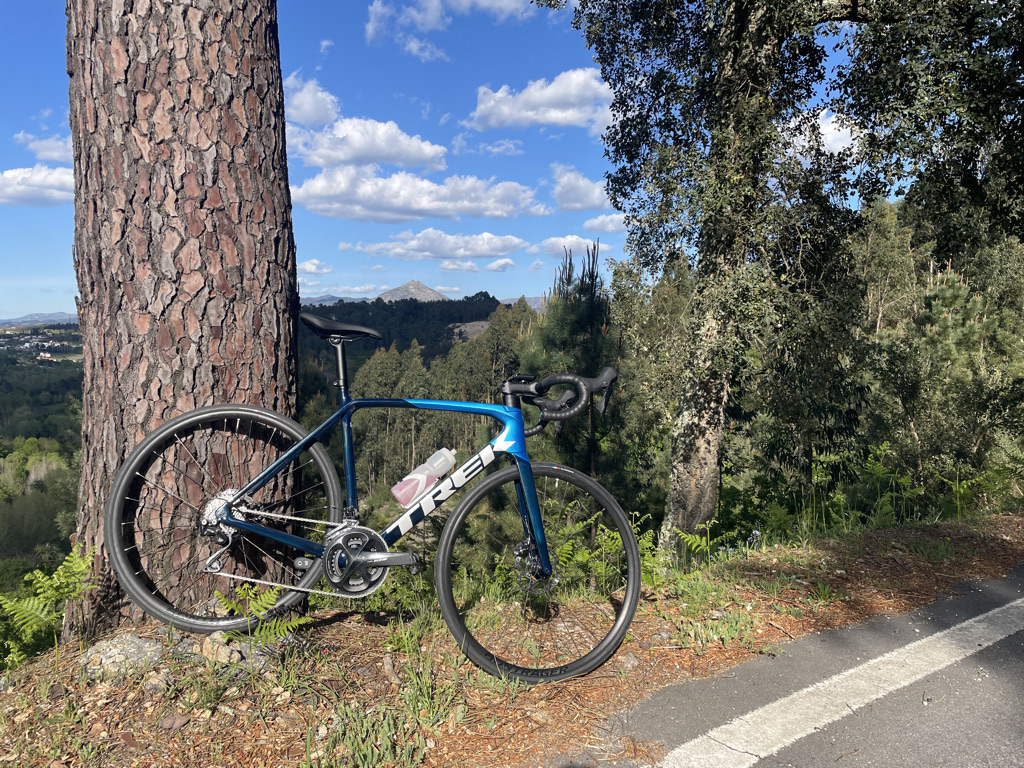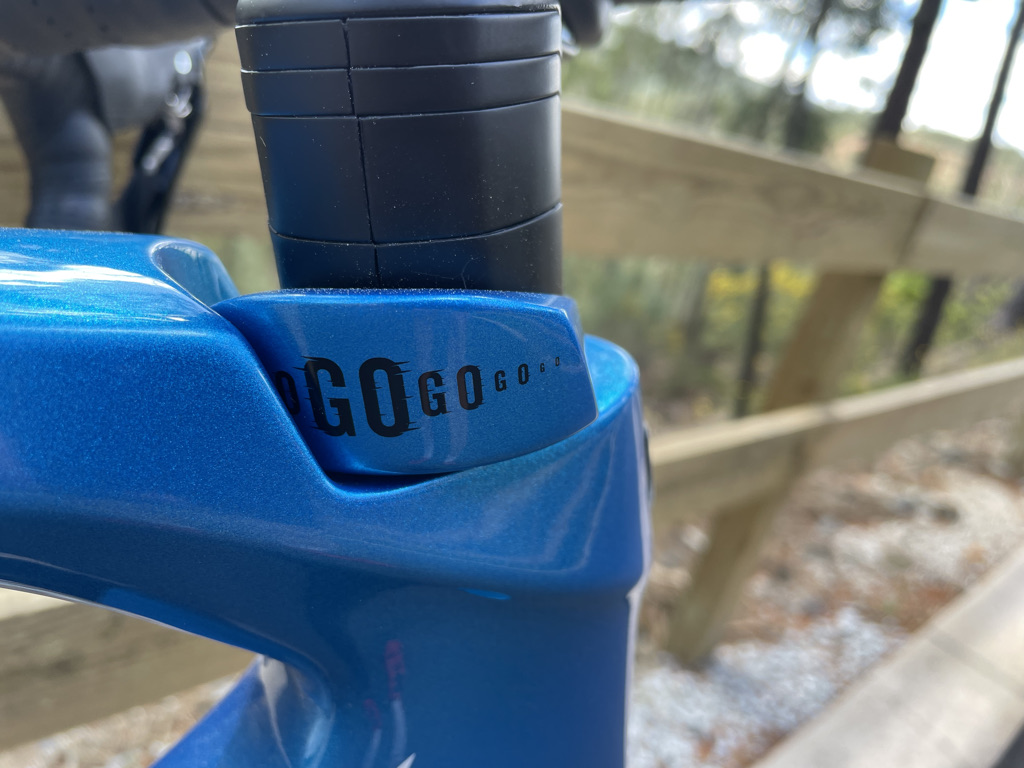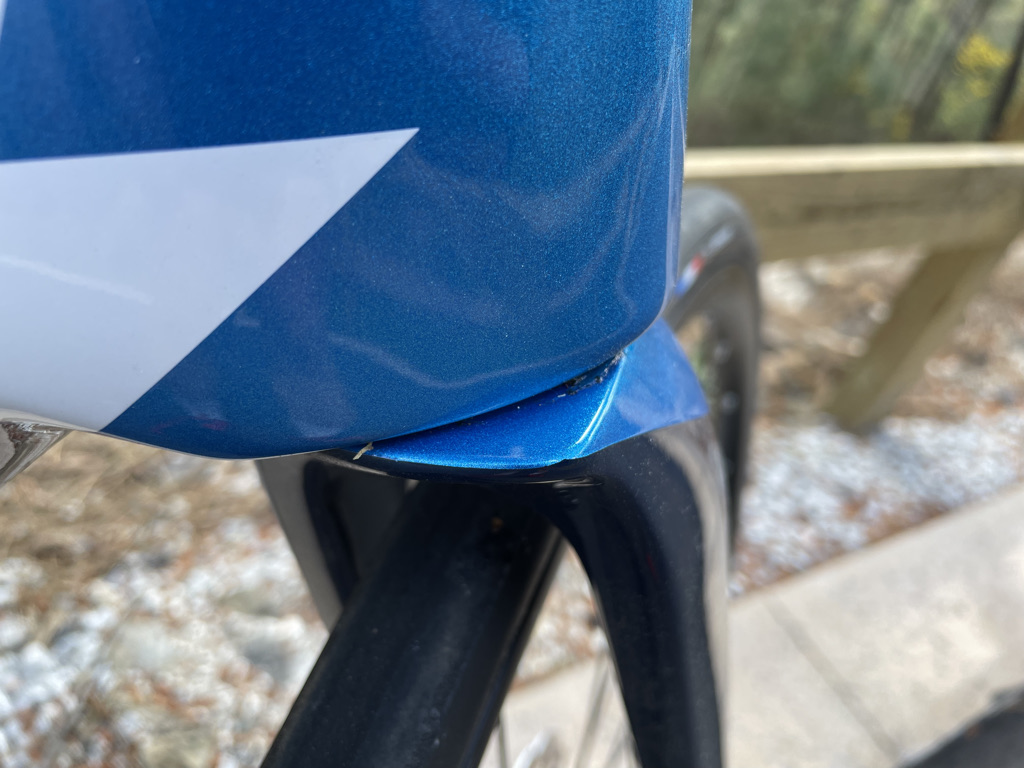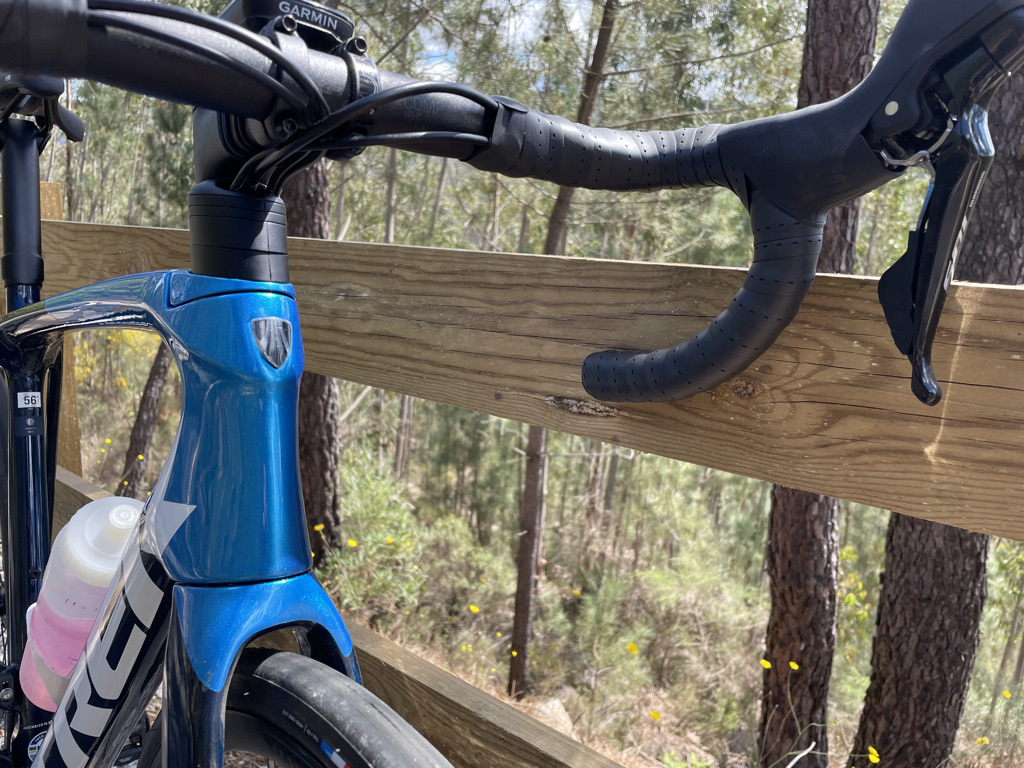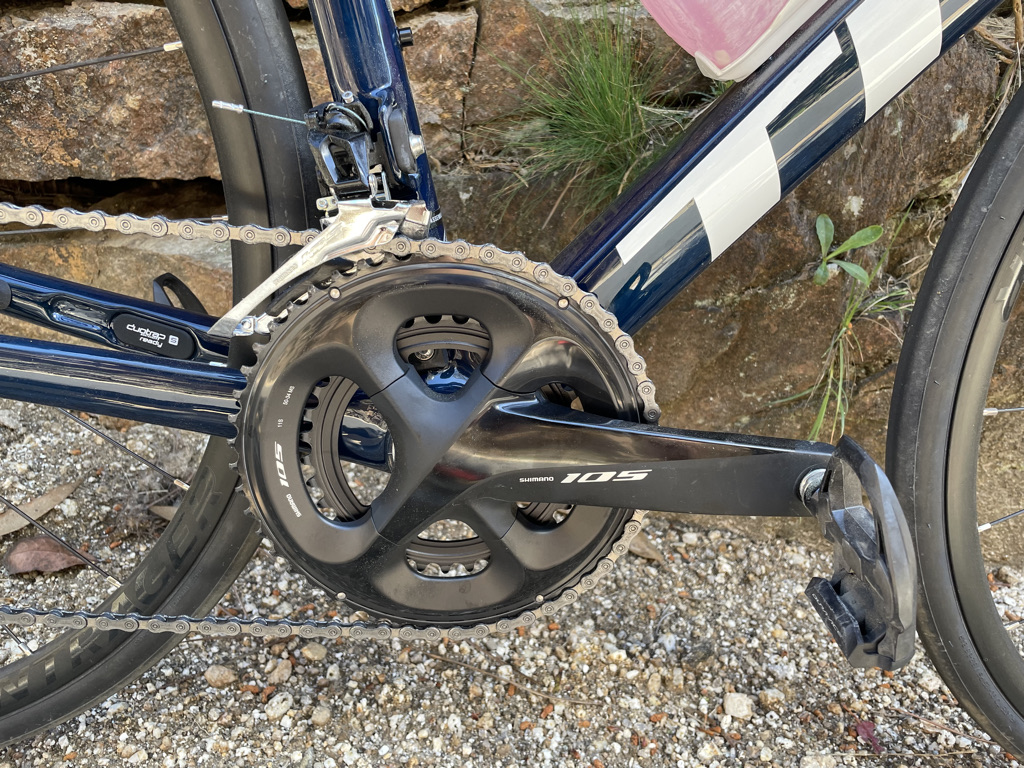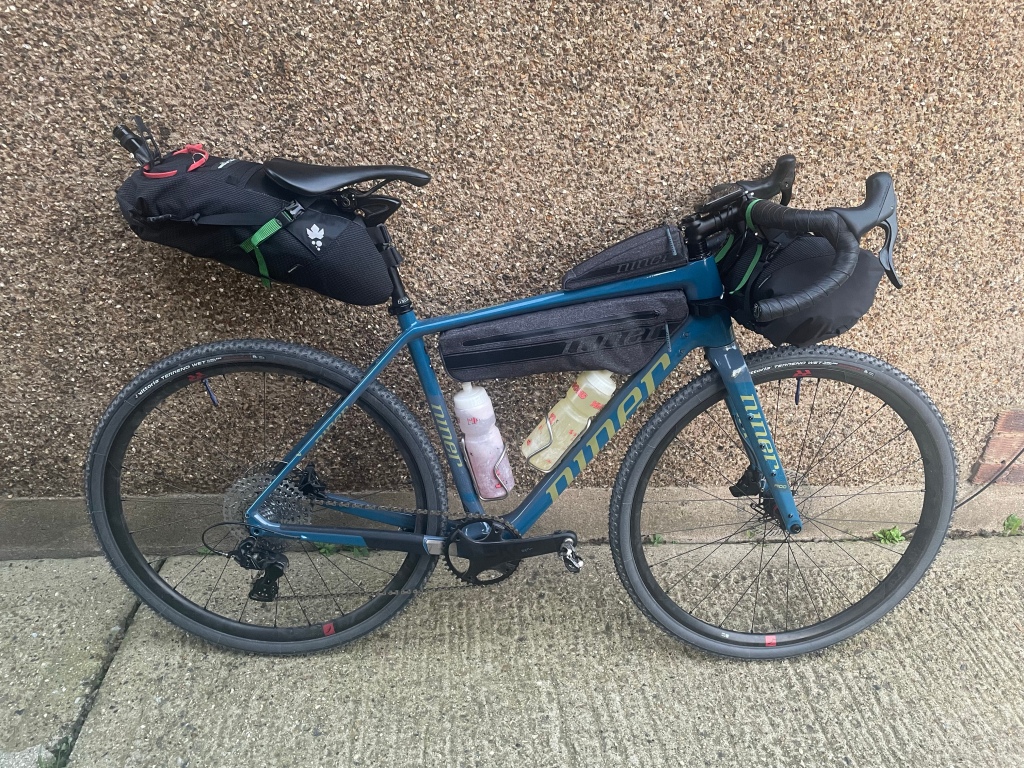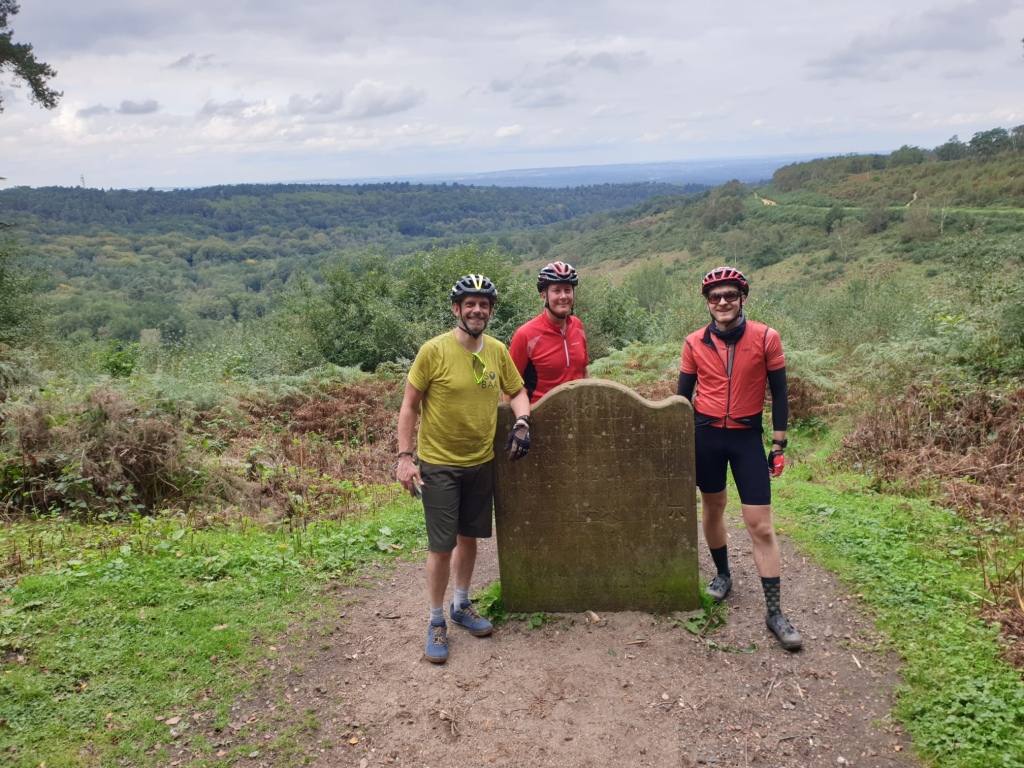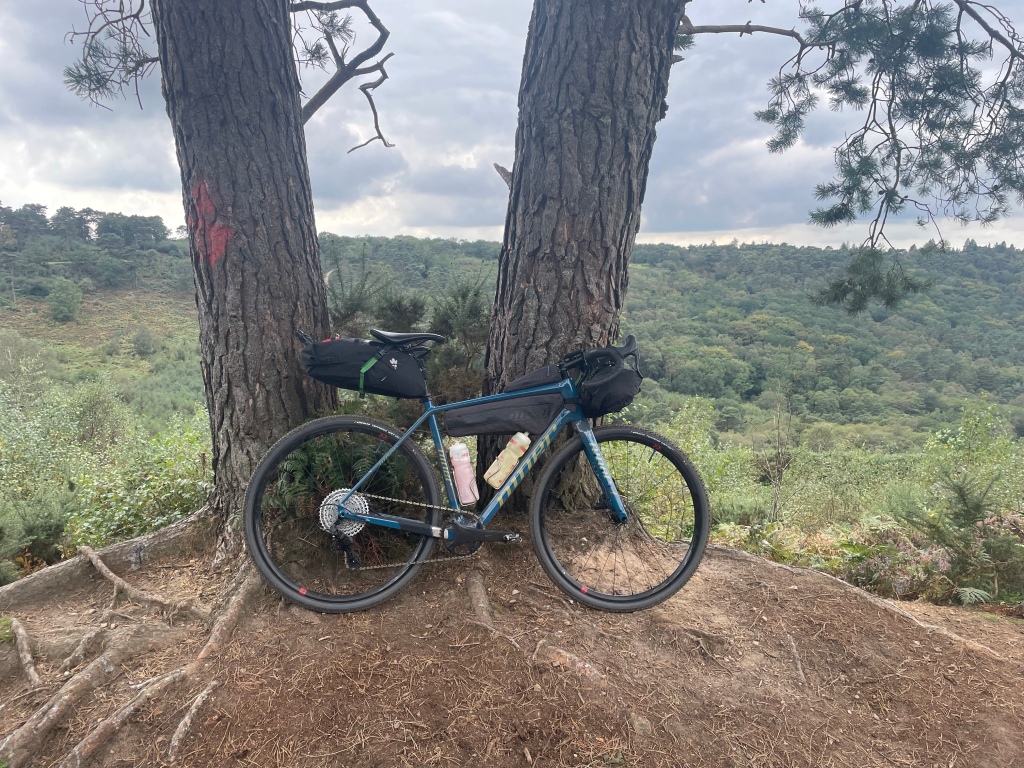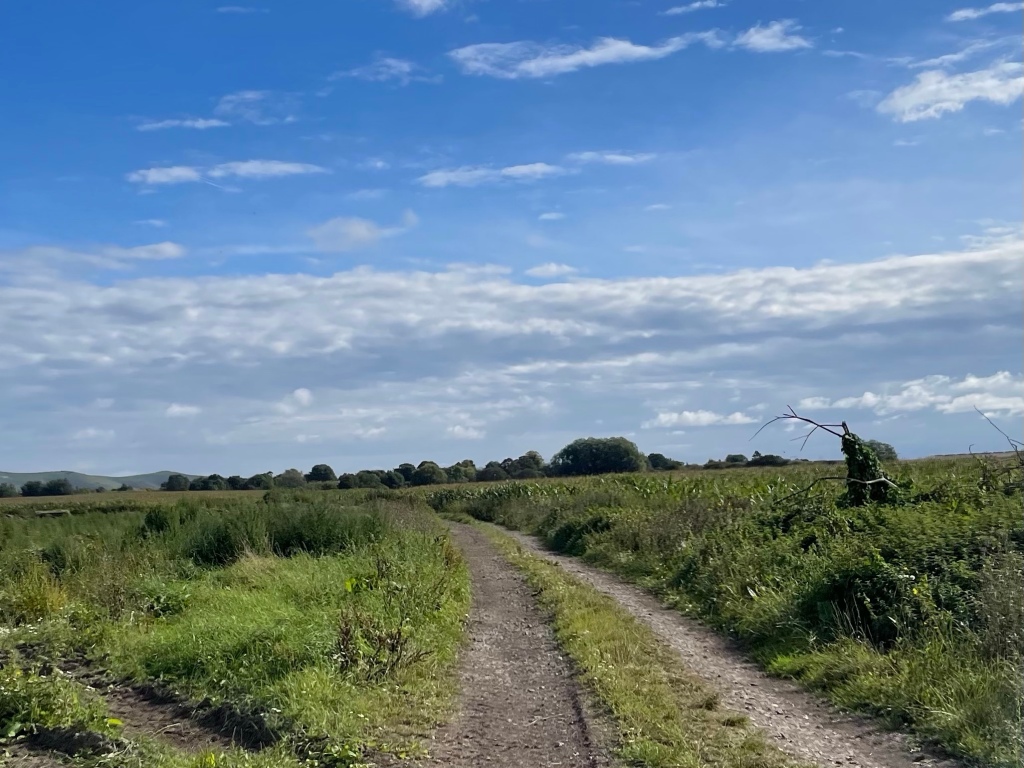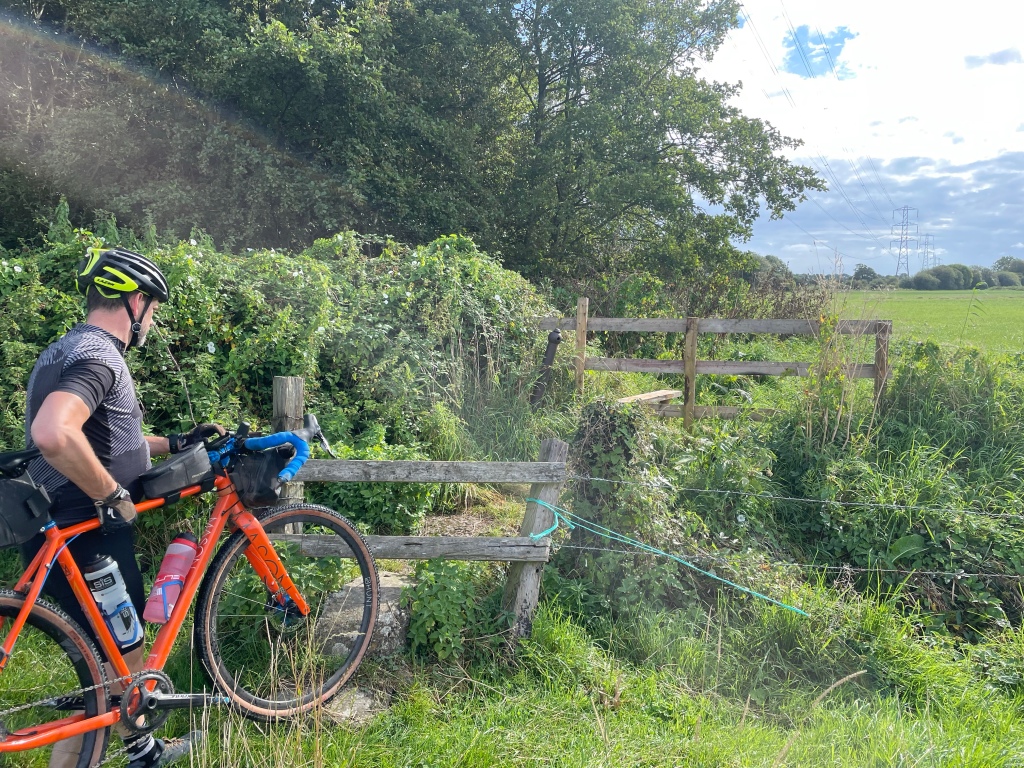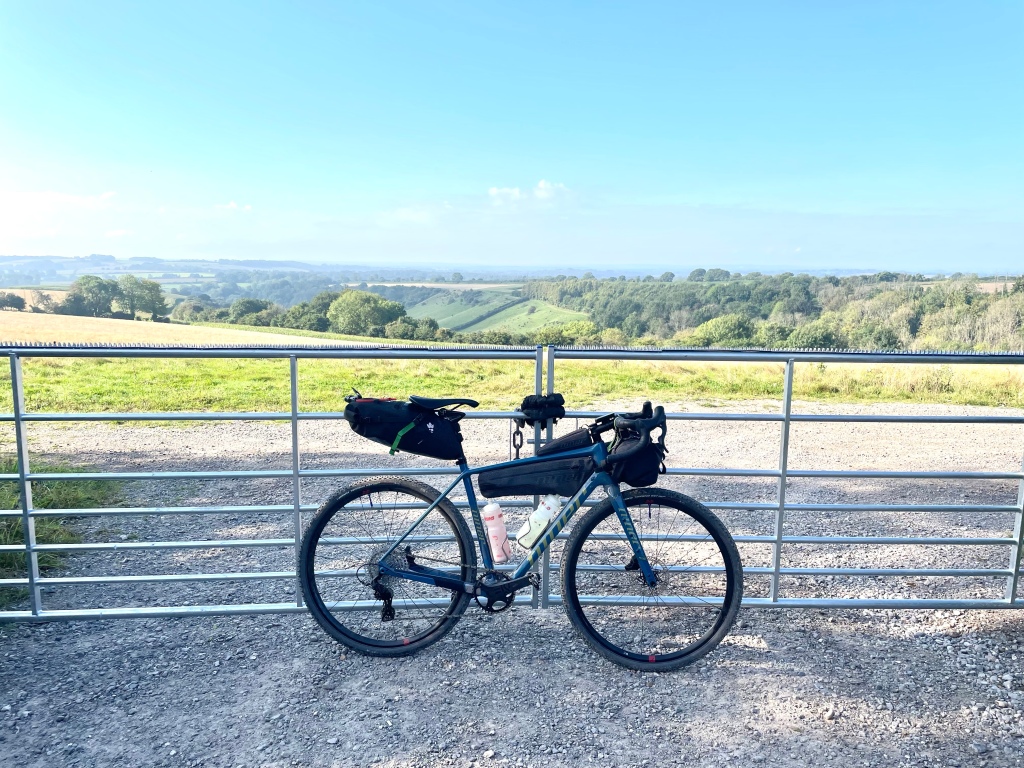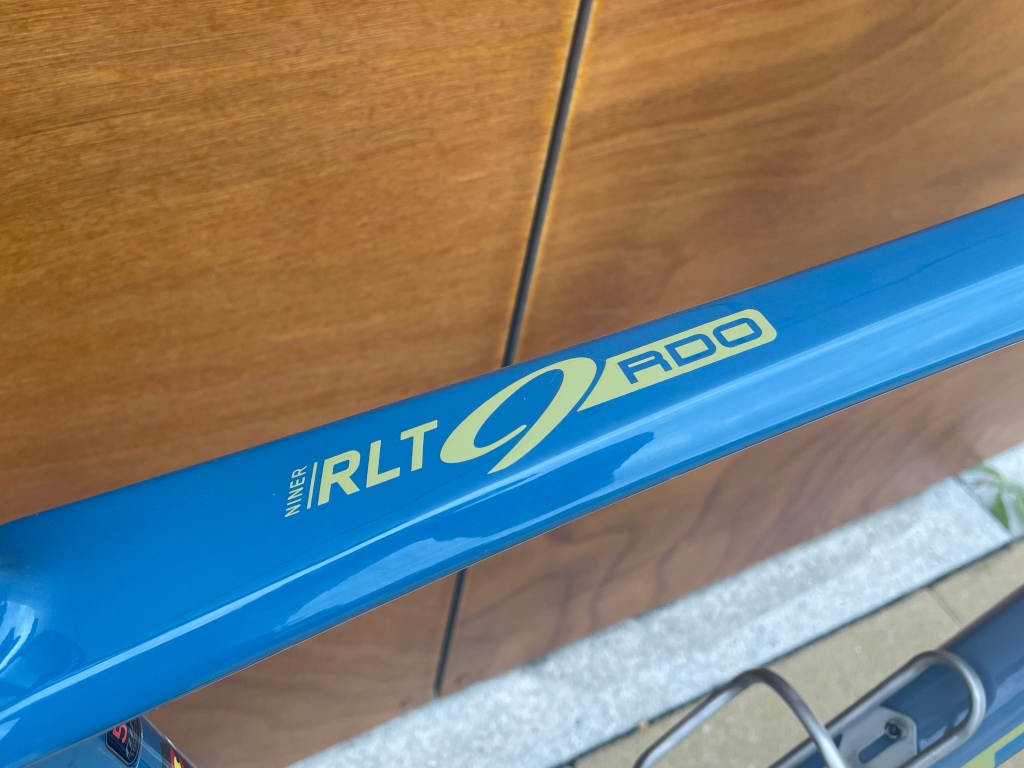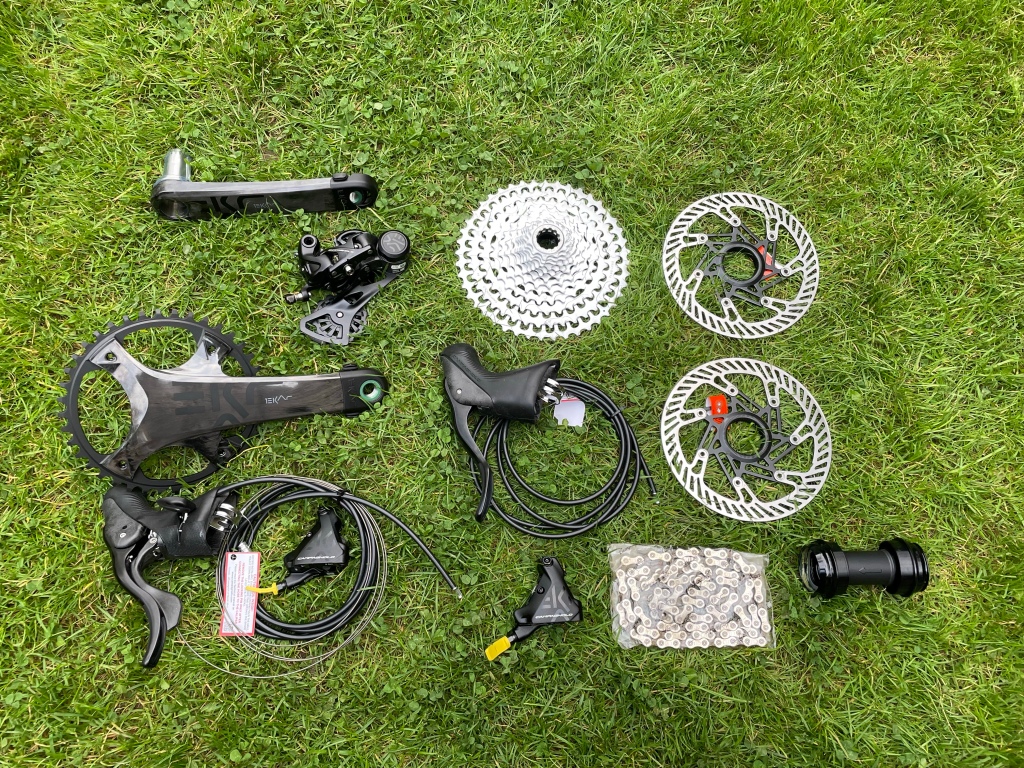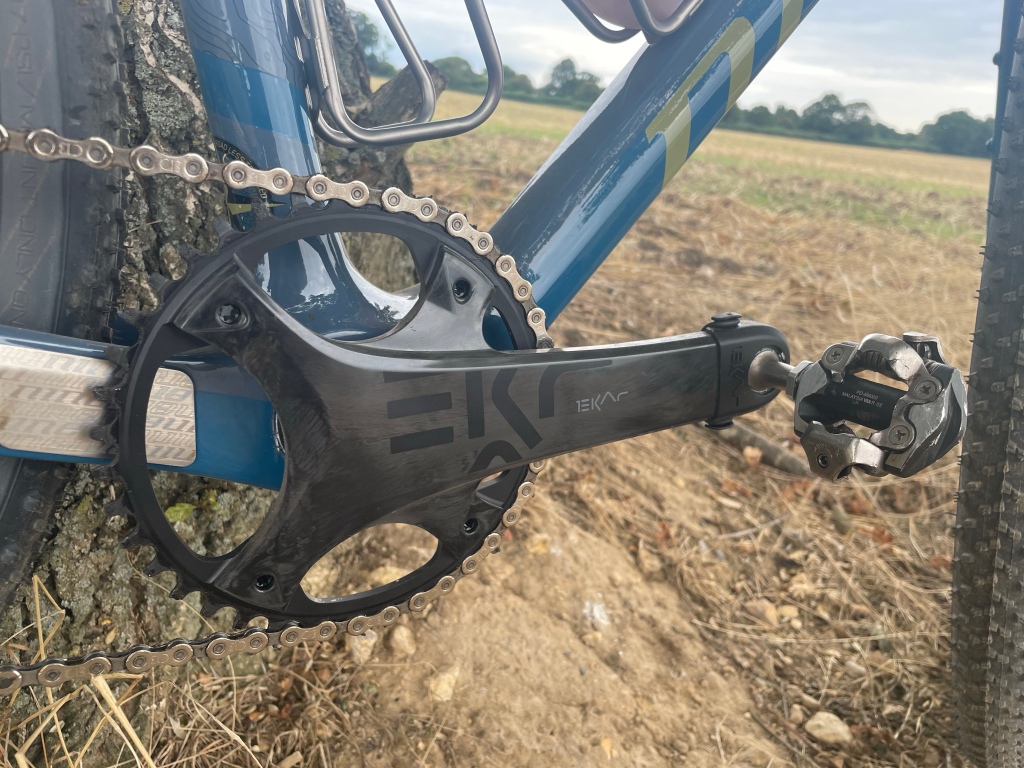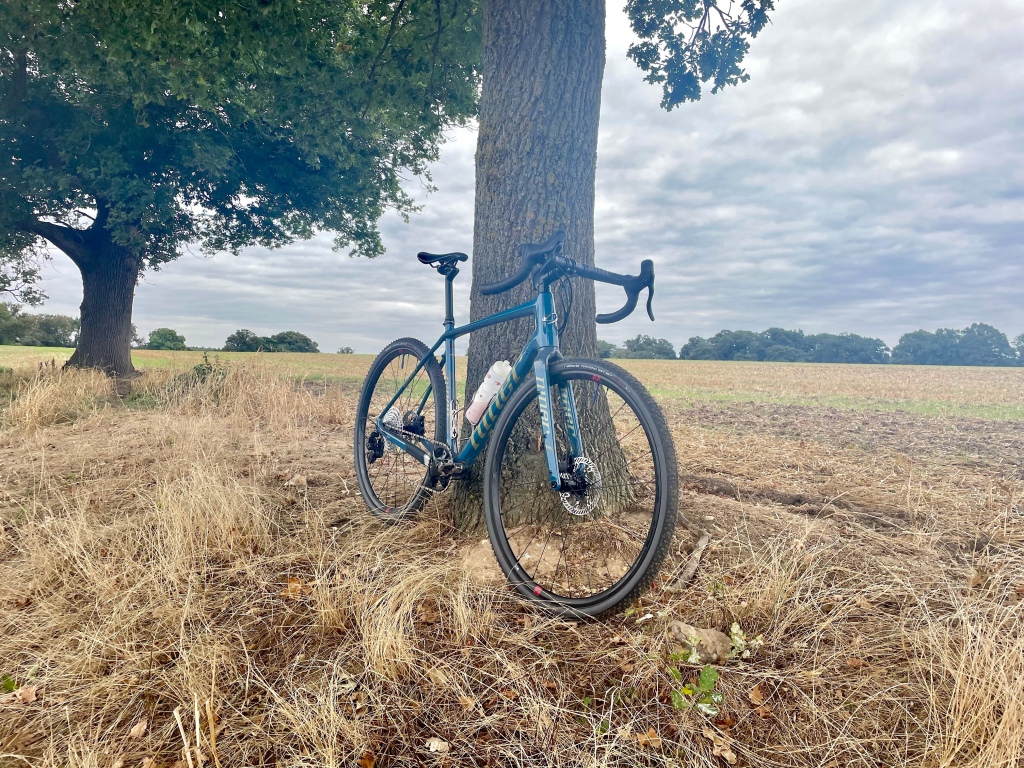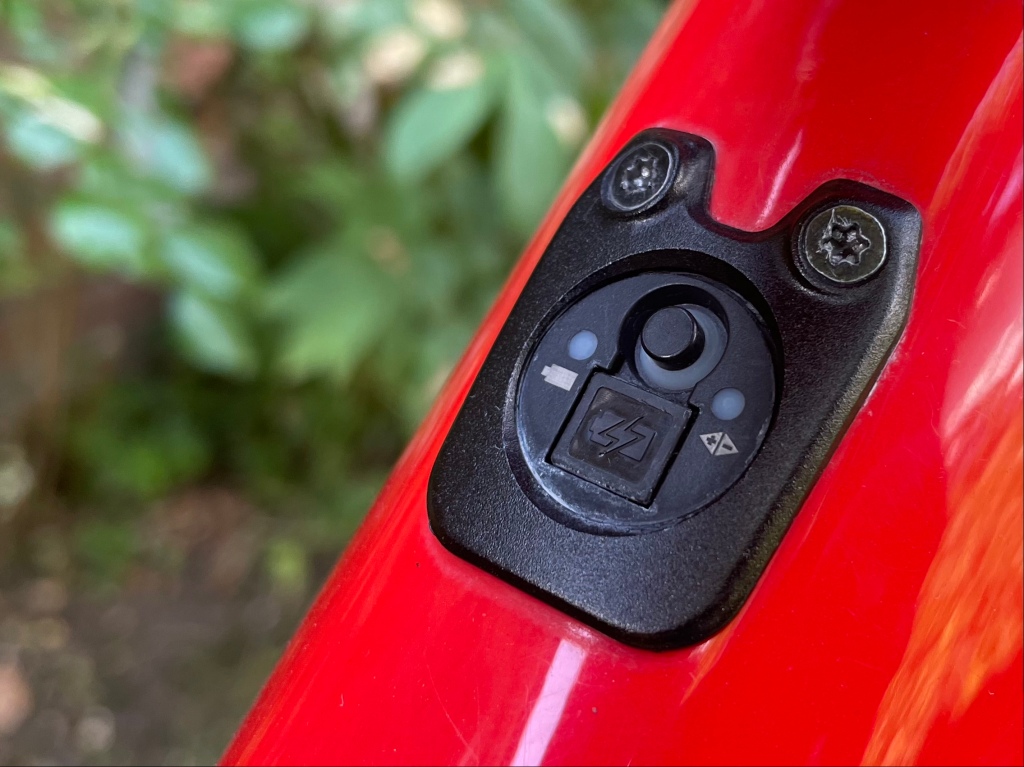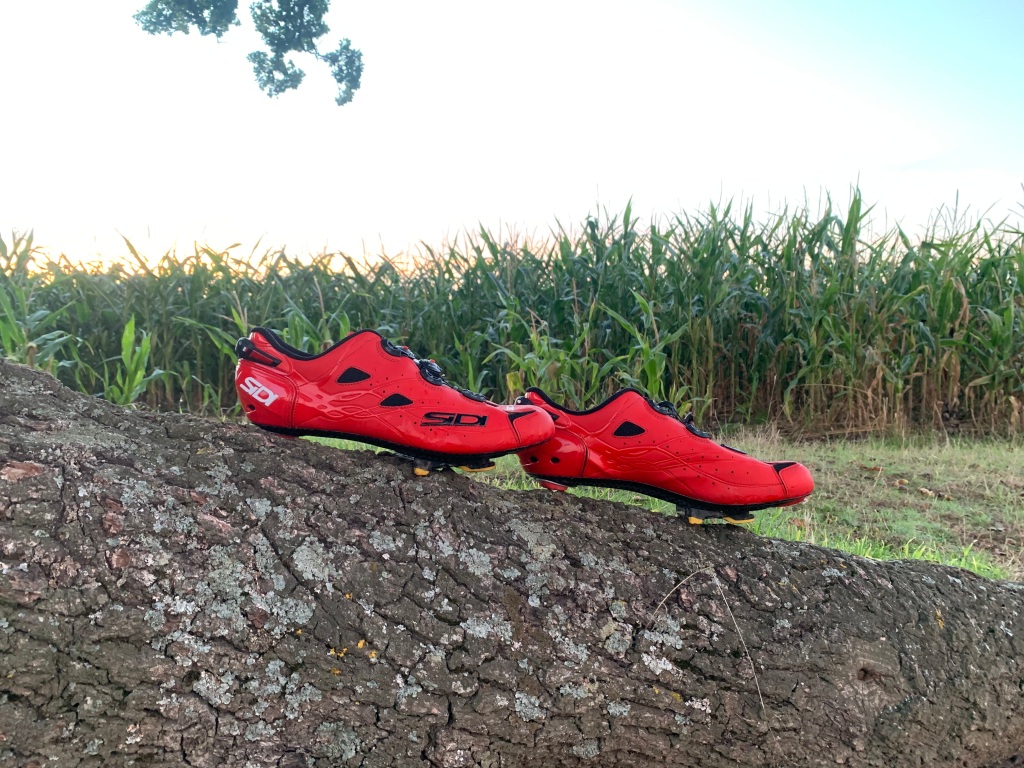The West Kernow Way is an off-road bikepacking route, devised by Cycling UK and historian / cycling journalist Guy Kesteven, connecting many of Cornwall’s landmarks and trails.
It officially starts in the town of Penzance and the route takes you on what is effectively a figure-of-eight loop around western peninsula of Cornwall. The route include diversions to the Minack Theatre and Land’s End and The Lizard Point. Other points of interest include Cape Cornwall, The Loe and the mining trails around Redruth. The route ends in Marazion in front of St Michael’s Mount, before a pancake flat 3km trundle back to Penzance.
Having completed the King Alfred’s Way last year, I caught the bikepacking bug hard. Cycling UK announced the route in Autumn 2021 and seeing as September worked well for last year’s trip, I aimed to complete this route at a similar time.
I was originally going to ride the West Kernow Way with my friends, Rob and Charlie, who I rode the King Alfred’s Way with last year. However, that dwindled down to just myself and Rob nearer the start.
The West Kernow Way is a 236km route with 4,000m of elevation. Having learnt last year that 80 / 90 mile days were rather difficult to adhere to in the daylight, we decided to ride the route in three days so we could also enjoy the sights that Cornwall has to offer.
Day 1 would see us ride approximately 60 miles from Penzane to Porthleven, with stops to explore both The Minack Theatre and Land’s End.
Day 2 would be a shorter but equally hilly 45 mile day from Porthleven to Falmouth. Falmouth isn’t on the official route but B&B’s can be few and far between in Cornwall and that was where we happened to find one. This would mean an additional 5 mile downhill diversion from the village of Longdowns.
After a 5 mile ride back up to Longdowns, Day 3 was to be a 50 mile jaunt to the end of the route in Marazion.
The Bike
I once again used a gravel bike for this trip and Cycling UK recommend the route as suitable for both gravel and mountain bikes. My Niner RLT 9 RDO with a Campagnolo Ekar groupset made for an excellent companion on the King Alfred’s Way last year and I had planned to ride it again for this route.
However, I was commissioned to test and review a Berria Belador Allroad for BikeRadar. The Belador Allroad is the first gravel bike from the Spanish brand and it has a much racier agenda than my Niner. It most notably features a pivot at the seatstay junction called the ‘Active Flex Concept’ that delivers 26mm of movement. The bike features a SRAM Rival eTap AXS XPLR electronic groupset, carbon Zipp 303S wheels and a fully integrated front end.
Although it’s a gravel race bike, Berria says it’s suitable for bikepacking, so what better way to test that claim than to take it bikepacking?
I’d ridden around 400km on the Berria, prior to the West Kernow Way and had a good idea of how it handled. I was a little apprehensive as my initial impression was that it wasn’t the most comfortable, nor particularly composed over seriously technical terrain.
As for how it performed, you can read my full review over on BikeRadar.
Although I used bikepacking bags from Miss Grape last year, I was lucky enough to receive some Apidura bags from the brands’ Expedition series. I used the Expedition Handlebar Pack in a 9-litre volume, 4.5-litre compact-fit Frame Pack and the Expedition Saddle Pack in 14-litres. They all performed close to faultlessly.
One mistake I had made was forgetting my preferred Rapha Explore Powerweave shoes at my parents home in Berkshire the last time I headed back for an extended weekend. This meant I had to ride in a pair of Fizik Vento Ferox shoes, which I had tested for BikeRadar and didn’t particularly get on with.
Rob also rode a gravel bike and his also happened to be new. Earlier in the Summer, he placed an order for a Reilly Gradient and it had arrived a couple of weeks prior to this event. The Gradient features a titanium frame and offers a significantly more relaxed geometry over the Berria and is designed for bikepacking. The spec includes a SRAM Force eTap AXS XPLR electronic groupset with Miche wheels and Continental Terra Trail tyres.
Preparation
I’ve been on particularly good form this year, having moved to Bristol back in April for work. I’ve been riding largely the same distances as the last couple of years but I’ve also had to commute to the office three times a week, which is 8km each way. It may not seem like a lot but it all adds up. The riding around Bristol is far more undulating than Berkshire, where you can choose to ride a pan-flat route or head into the Chilterns or Surrey Hills which are typically shorter and steeper than the Cotswolds, Mendips or Wales.
My tactic for the King Alfred’s Way paid off last year and so I replicated it again this year. I don’t have a problem with riding these distances off-road but it’s a different story when you’re riding this on consecutive days. This meant I got some weekends in of three to four consecutive long rides and started to taper down a couple of weeks prior to the event. I’d also been fortunate to ride a Canyon Endurace in Sardinia back in July, which helped with training for the elevation.
On the afternoon before our first day of riding, I met Rob at Bristol Temple Meads station and after cycling back to my flat, we embarked on the 200 mile journey down to Cornwall. The journey ended up being rather eventful as Rob had taken the wrong train at one stage earlier and we had set off later than expected at around 5pm. This meant we inevitably got stuck in some pretty grim motorway traffic pretty much instantly on joining the M5 after the Almondsbury Interchange.
We’d booked a hostel in Penzance for the first night that allowed check-in until 10pm and the traffic jam put a fairly significant dent into our journey. We realised after passing through Exeter that it was going to be tight timing and save for a nature break and a swift and economical meal at a McDonald’s, I had to put pedal to the metal on the accelerator of my Ford KA, which is rather shy above 60mph.
Luckily, we just made it to the hostel in time and after getting my bikepacking bags packed for the morning, I attempted to hit the hay. Hostels really aren’t my bag but this was the bargain of the trip at £30. The next two nights were fortunately to be at B&B’s.
Luckily, the room that could sleep eight wasn’t at full capacity and we just had two others to share the room with. Still, it was pretty ferociously hot and opening the window didn’t really achieve anything so I didn’t have a particularly good night sleep.
Day 1
It felt surreal that this day I’d been training for a while had finally arrived. After a rather hearty breakfast at the hostel (although not as substantial as Rob’s cereal, followed by full English, then toast and pastries!), we got everything packed.
We thought we’d try our luck by seeing if we could leave the car at the hostel for the three days but that plan expectedly failed. Luckily, I had spotted on a West Kernow Way Facebook group that I am part of that you could park at Sainsbury’s in Penzance via the YourParkingSpace app for just over a tenner.
We made the short journey to Sainsbury’s, parked the car and got the bikes ready to go. Between us, we’d taken three pumps – I had a Silca Tattico mini-pump and a larger Lezyne digital mini track pump, whereas Rob had something in between size-wise. We decided that as we were both riding relatively new tyres and Rob had tubeless bacon strips, should the worst happen, that I’d carry the small Silca pump.
Onto the bike and straightaway, a bus gave me some ‘encouragement’ as I turned out of the supermarket car park, clearly unhappy that his journey would be inconvenienced by 30 seconds. After about a kilometre, we arrived in the centre of Penzance which is the official start of the route. Rob and I made sure to take a photograph at the start overlooking the picturesque beach.
The route was reasonably flat through Penzance as it straddled the paved coastline and about 5km in just before reaching Mousehole, I noticed Rob only had one bottle on his bike, having left the other in the car. Rather than turn back and retrieve it, Rob decided that if we came across a bike shop, he’d buy one. Despite Rob only having one large bottle, we had roughly the same amount of water as the Berria’s bottle cage clearance with the Apidura frame pack was pretty wanting, so I had two small 500ml bottles.
Riding through the charming town of Mousehole, Rob briefly stopped at a bakery to see if he could buy a plastic bottle of water to carry but to no avail. The hill out of Mousehole was pretty disgusting, although at least it was paved. This was followed by an equally steep and twisty descent into Lamorna.
We’d reached our first off-road section of the day, which was a brief but picturesque climb through the trees up to a road. A reasonably undulating but steady 10km or so followed and we reached out first route diversion of the day to the Minack Theatre. The diversion saw a fairly long descent and then a short, sharp climb to the car park.
We were welcomed by the mesmerising views of Porthcurno beach, one of the top rated beaches in the UK. After a photo opportunity, we explored the Minack Theatre, a spectacular open air theatre perched on the cliffs overlooking Porthcurno beach. After an explore and brief sit-down to watch part of a rehearsal, we had a quick coffee and then got back on the bikes as it was already midday and we’d ridden 20km.
Rob suggested the prospect of lunch at Land’s End but that was only going to be roughly 32km in to a 96km day, so we agreed we’d try and eat at around the half-way mark.
The route to Land’s End was virtually all on the road, bar one muddy trail where I got to put the Vittoria Terreno Dry tyres to the test on my Berria. It wouldn’t be unexpected to report that grip wasn’t ideal.
We reached the route diversion for Land’s End as we met the A30 and turned onto it. After a kilometre or so of road, the route takes you on The Cornish Way trail, a gravel track which was glorious, with arresting vistas of Sennen Cove. It’s definitely up there with the highlights of the trip.
Now at the farthest point of the UK, a brief wander around Land’s End revealed the iconic signpost now required payment if you wanted a photo taken in front of it. There is now a kiosk next to the sign where a photographer captures an image of you and can then send you hard copies or a downloadable file. We thought “Screw it,” and I took an image of the sign in between customers walking up to it and we then had a short stop for ice-cream.
We followed the magnificent Cornish Way back to the A30 and decided we’d try and get a solid couple of hours riding in to make up some of the distance before stopping for lunch.
Almost instantly after we set off, Rob’s rear tyre looked on the low side and we stopped to inflate it – this would go on to become a running theme of the trip. Rob was running Continental Terra Trail tyres and had set them up tubeless. Neither of us could find any problems with the tyre or the tubeless valve.
It was largely more of the same in terms of terrain – lumpy road until around 42km. A few minutes before the gravel arrived, I had remarked it was disappointing there had only been a stingy portion so far. I certainly got what I asked for.
We were faced with a viciously steep ascent on loose rock, where it could have been very easy to lose momentum if you picked the wrong line.
This was then followed by an equally loose descent that we had to carefully pick our way down. The surface mellowed for a kilometre or so and we had another fairly rocky climb followed by another technical descent where the SRAM brakes got called into action. Additional spice featured with two walkers walking up the opposite way and whenever you’re trying to negotiate a technical descent where the slightest wrong choice could go wrong, you don’t want to embarrass yourself!
The descent featured stunning views of Cape Cornwall and once we reached the bottom, we had a brief explore and photo opportunity. We then reached a road climb that would lead us to the town of St Just where I passed a cyclist on a carbon framed road bike sans luggage, who wasn’t particularly impressed I’d gone past with bags galore and wide 700 x 38mm tyres!
It wasn’t long before we arrived on off-road terrain again as the route hugs the coastline before turning inland at Trewellard. The terrain here was ideal for a gravel bike – relatively fine gravel with some grass and meadowland thrown in, another highlight of the day.
After a while though, this turned into some seriously technical singletrack with some interesting gate designs thrown in for good measure. The paths were very narrow with frequent galleys and sharp rocks that could rip your tyres if you rode at the wrong angle. Whilst this section was fun, it was very slow-going and would probably be more suited to a hardtail mountain bike.
At one point, Rob looked like he was going to stack it as he came in rather hot on a brief drop that had a sharp rock next to it which he tried to avoid. Shortly after, I experienced a slow-motion fall where I took the wrong angle on a path and only hurt my pride briefly. It took us a good hour to ride what was 12km or so but it just shows the contrast in terrain the West Kernow Way can offer – the first 40km on the road may be fairly easy going but then you can get quite literally bogged down in singletrack and make slow progress.
This extended singletrack section finished with a pretty epic but tricky descent that had some metal barriers every 100m or so for good measure! I was feeling both ready for some food and I was getting in quite a desperate state to refill my bottles once we hit the road. As is typical for this type of ride, there was bugger-all around and it didn’t look like we were going to find civilisation until we’d reach the town of St Erth.
A little later than expected, we’d reached the A30 at Canonstown and thought there must be a shop or pub here but alas, nada! A brief look at the map revealed we weren’t too far from the picturesque town of Lelant but it would be a 4-5km diversion. Fortunately, I then struck gold as I spotted a service station on the map about a mile down the road and we thought this would be our best shot.
We stocked up on water and I had an enormous Cornish pasty and full sugar Coke, while Rob had a sandwich and brought some cherry glazed cakes. We had a cake each and normally, it would have been sickly sweet but this was just the ticket for now.
Refuelled and refreshed, we rode back up the A30 to pick the route up again which was predominantly small, leaf-stricken roads for a couple of kilometres. We experienced a slight GPX route faux-pas where our navigation wanted us to head through someone’s driveway and after a brief moment of research, we worked out there was a trail that circled the property to avoid this error.
As the route continued to be a mixture of mud-stricken roads and even muddier trails, I was pretty tired and the expected service station stop renounce hadn’t kicked in. One tough climb was particularly boggy and I’d somehow managed to get a stone in my shoe. I had to perform acrobatics to carefully take my shoe off, extract the stone and put it back on without my foot meeting sloppy mud.
The route continued to be annoyingly undulating and after a pleasant heather-infested section atop a hill, we reached a rather interesting gate with a sign indicating the trail was to become a footpath. Rob suggested turning back but I stubbornly wanted to continue the route and if it meant a brief walk for a footpath past a farmer’s property, so be it.
Once we’d walked through, we were greeted by the breathtaking view of Porthleven and we knew we were only but a descent away. The descent into Porthleven was excellent and went on for a long time and we reached the picturesque town and located our sleeping quarters for the night.
Porthleven is an ideal place to split the route as the second half of Day 1’s route was fairly difficult and consistently up-down. Performance-wise, I hadn’t had the best of days as I found the 30km or so a real trudge in places and the service station stop hadn’t really been of benefit, other than to hydrate. 60 miles may not seem a lot but in these conditions, it’s more than enough.
Rob and I had a beer at The Harbour Inn on the harbour to celebrate our efforts and then ate a disappointingly small and overpriced ‘large’ fish and chips at The Ship Inn – whilst the pub was rammed and had character, I’d recommend heading elsewhere if you’re after a meal.
Total distance: 96.7km
Total elevation: 1,603m
Day 2
After a rejuvenating eight hour’s sleep, Rob and I enjoyed a delicious breakfast at The Harbour Inn and set off just after 10am. Today was to be a shorter 45 miles to Longdowns, followed by five or so miles to our B&B in Falmouth but with equal elevation to yesterday. With 60 miles and 1,600m of climbing in the legs from yesterday, it’d be safe to say the legs didn’t feel particularly fresh. Rain was also forecast until around 1pm, although as we started to get the bikes ready for the day, there was some coastal mist. I decided it was best just to stick my waterproof on straightaway.
We headed out via Porthleven’s harbour and after a short 60m road climb, we were greeted by our first off-road section of the day. The route overlooks the coastline and after a relatively steep descent, you get a glimpse of The Loe.
The Loe is Cornwall’s largest freshwater lake, separated by the sea via a picturesque beach. After some picture-taking, we diverted off the route to have a further explore and Rob suggested the idea of skipping the beach to avoid unnecessarily ruining the bike’s drivetrains.
The route around The Loe was fabulous, the lake cutting an imposing presence – it’s a slice of heaven for walkers or cyclists who are lucky enough to live in this area. After cycling past the National Trust cafe and reaching the other side of the lake, we discovered the diversion would add more mileage than it was worth, so we decided to head back up again and cross the beach. At this point, it started to rain.
That’s just what we did and after trundling back up the climb to where we made our diversion, we descended down to the beach. The beach wasn’t rideable so we got off and walked and I took the opportunity to get my ‘money shot’ photo of the Berria, to insert it into my BikeRadar review where I mention I took it bikepacking. It took a couple of goes to get it and involved strategic placement of pebbles but the end result was pretty good.
As we neared the other side of the beach, it really started to rain at this point and Rob donned his waterproof gear. An off-road climb led us to the road, which would take us to Mullion. The road was briefly interrupted by a short yet upsetting, sandy and rutted climb through a gold course.
The route took to the trails once again after we passed through the village, and it was more of the same rutted gravel with a beautiful heather-infested backdrop. There was one particularly rocky climb that was technically a footpath that necessitated walking and we then passed over a footbridge before being rewarded with spectacular views of Kynance Cove.
After a brief stint on the road, we found ourselves passing through Lizard’s village centre. We diverted off the road to check out the Lizard Point before heading back for a bite to eat. The Lizard Point was another stunning attraction with its domineering lighthouse and the view of freight ships in the distance. By this point the rain had also more or less stopped.
We rode back into the village and enjoyed a pasty and ice cream. With all the stopping and starting, it had taken us the best part of four hours to ride a little over 30km and with another 50km or so, we agreed to try and get a couple of hours in before stopping again. Looking at the prescribed route, potential places to stop looked few and far between so we thought if we happened to ride past a cafe or pub, we’d just stop then.
I found the next 25 miles or so to be a real slog and the route is virtually all road. It’s fairly flat-going until you reach the town of Coverack and I felt on decent form, taking a few long turns on the front to try and make up some of the distance.
The road descent into Coverack was particularly steep and technical and after a brief stop to check out the viewpoint, we started to make our way out of the town. A 4×4 driver (surprisingly not an Audi or BMW!) was stopped blocking the road for all other traffic, so we carefully negotiated ourselves past the offending vehicle.
We quickly saw an unpleasant sign warning of a steep uphill gradient and we winched our way up the unpleasant climb to the top.
The gradients would prove to never be quite as steep as the climb out of Coverack as we began to traverse our way around the Helford River. Although it was all road-based, this section was quite tedious and up-down.
We pushed on until we reached Gweek, where we stopped for a coffee and cake. Rob also brought a Kernow cake, which looked the size of a brick, as an additional fuel reserve should we need it. Although the coffee wasn’t the best quality, a coffee and cake came in at £2.50 – bargain of the ride!
The climb out of Gweek was another unpleasantly steep one and after 25 miles or so of road, I thanked the Cycling UK gods for introducing a brief gravel track. We also got to cross a ford, which is always fun. After a short stretch of road, we then found ourselves on an excellent wooded section.
Our fun was briefly interrupted by an impassable bridge and Rob decided to circle back whereas I crossed the stream running underneath and surprise, surprise, managed to stick one of my shoes in the water.
After a muddy climb, we reached the village of Constantine where Rob stopped at a shop to buy some water and we then carried on towards Longdowns. I was quite ready to call it a day at this point and the last couple of climbs up to Longdowns were far from my best moments.
I looked at my Garmin once we had reached the end of today’s route and saw we were 180m up high. This was going to be a fun climb in the morning! The descent into Penryn was long and steep and after passing through an industrial park and the town centre, we arrived in Falmouth. Rob’s Hammerhead chucked another unpleasant climb at us, which we later discovered proved unnecessary.
We then started to look for the Jacob’s Ladder Inn, which would be our B&B for the night. A work colleague of mine who studied at Falmouth warned me the B&B had this name for a reason and the ‘ladder’ would be a long set of steps. He wasn’t wrong and when we saw the steps we’d have to scale, we decided to carry on riding up the road and take the long way around, up yet another climb, to reach our destination.
We reached the B&B and after a well-needed shower, it transpired the hotel had stopped serving food. After a quick WhatsApp message for food recommendations in Falmouth to my work colleague, we headed to The Gurkha for excellent Nepalese cuisine that was far more substantial than the disappointing fish and chips the night before. We washed it down with a beer at the Beerwulf, a pub in a book shop setting which was rather cool and the only pub I’ve ever been to where the predominantly student demographic had brought in their own takeaways and were allowed to eat them on the premises.
Day 2 was expectedly tough and the highlights were certainly the first 30km up to the Lizard Point. The 25 mile road drag was tedious though.
Although we rode around the Helford river, if it’s open and running and you can spare the cash, I’d recommend taking the ferry diversion Cycling UK offers at Helford. You’re really not missing much riding around the river and your legs will thank you for it, although your wallet might complain a little. I was reading on a West Kernow Way Facebook group that the ferryman charges around £20 per passenger per crossing, which is rather a lot!
Total distance: 86.4km
Total elevation: 1,582m
Day 3
After a decent sleep but not as restorative as the night before, we got the bikes ready before breakfast and sat down to eat just after 8am. I didn’t feel quite at 100% and felt as if I had the beginnings of a cold coming but this could equally have been the result of two full-on days.
We needed to finish the route and be back at Bristol Temple Meads station for before 8pm as Rob had a train to catch. Taking into account how long the first two days had taken us and estimating a five hour journey back with stops, we had our work cut out! Rob suggested editing the route down but this isn’t in the spirit of bikepacking and I was confident we could get it done.
The ride up the hill to Longdowns made for a particularly depressing start, my legs refusing to spring into action. Once we hit the official route, after a handful of lanes, we hit the first extended off-road section of the day through grass and mud. My legs still refused to wake up, although Rob inversely was on fine form.
However, this soon changed as unluckily for Rob, last night’s Nepalese came back to haunt him. I rolled on and finally started to find a bit of form. When Rob caught up, we passed a rather picturesque reservoir before hitting the lanes again, which remained undulating in true Cornish fashion.
This then turned into a heather-infested off-road trail and after a bit of a dicy 180 degree turn almost back on ourselves, we hit the Mining Trails. This is a 37.5 mile network of trails that span the towns of Redruth and Camborne and are also popular with walkers, horse riders and mountain bikers.
This was a real highlight of the day and I’d love to revisit this section to explore it in further detail.
The route predominantly sticks to these trails up to Portreath, with a few faster roads thrown in for added variety. Although only 40km in and feeling strong, Portreath seemed like the sensible place to stop for lunch, given there didn’t seem to be a great number of larger villages or towns until the end.
We quickly found a bakery and we both had a steaming hot pasty each – this may have been the pasty of the trip for me and the beef was excellent quality.
The route out of Portreath was tranquil and after passing through a modern estate, we quickly hit the mining trails again. Annoyingly, my form seemed to have disappeared again and I was back to square one, really struggling in places. I can only think this was down to the sizeable lunch.
We passed the picturesque Carn Brea and the off-road sections started to become more rugged, yet still undulating as we left the Camborne area. I was really running on fumes and getting quite frustrated with myself. I’d eaten and drunk a fair amount and had kept topping myself up, so there should be no reason for this lack of performance.
This carried on for a couple of hours or so and I then miraculously found some form again. At one point heading through a village, we passed two other rides on hybrid bikes, embarking on the West Kernow Way. They would prove to be the only riders we would come across on the whole trip, compared to the many cyclists I came across every day on the King Alfred’s Way.
This part of the route generally felt more jurassic in landscape and I knew we couldn’t be too far away from the finish once the Angarrack railway viaduct came into sight.
We rode down a particularly hairy descent which I remember feeling relieved I didn’t have to climb on the way down and we crossed a footbridge over a river. The route advised us to head straight across but this wasn’t an option.
After a few minutes of finding our bearings, we followed the path in either direction but this would lead away from the route. This was a rare GPX routing faux pas from Cycling UK and we crossed back over the footbridge and up the bastard climb. Rob routed us on the road through St Erth, where a closed road looked like it may put pay to the day but the builders kindly let us through.
Ten or so kilometres added to the route, we found ourselves back on course and heading for the finish at Marazion. The last 5km felt noticeably flatter and we reached the end at Marazion, with the view of St Michael’s Mount in the distance.
After some obligatory photography, we rode the couple of kilometres back to the Sainsbury’s car park in Penzance and made our journey homeward bound. And if you were wondering, we made it back to Bristol Temple Meads station in good time.
Day 3 was a noticeably flatter but perhaps the most varied route of the three days, with no annoying extended road sections to deal with. My performance was strange and I haven’t suffered on the bike as I did in places here in many a year. I’d love to head back and explore more of this beautiful area and the Mining Trails were easily the highlight of the day.
Total distance: 93.7km
Total elevation: 1,384m
West Kernow Way Reflection
The West Kernow Way proved an excellent bikepacking trip and the route mostly delivers on its picturesque settings and landmarks. There’s certainly a lot more road than King Alfred’s Way though, which I didn’t expect, and this is why a gravel bike with wide clearances makes for the best option as it’ll be hard-going on a mountain bike. This is especially true of the numerous gates or obstacles to negotiate, where the extra weight of a mountain bike would be a hindrance.
The highlight of the trip was probably riding around The Loe on Day 2, despite it not being as large an attraction as other landmarks on the trip.
Choosing to ride the route in three days was the perfect decision, as bar the last day, we got to explore the surroundings at our own pace and truly appreciate the sights it has to offer. You could do it in two days if you missed the various stops the route takes you on but you’d be in for an unpleasantly undulating mid-section.
Despite my poor performance at times this time around, I found the King Alfred’s Way a more challenging route. The hardest climb of the West Kernow Way is undoubtedly the rocky ascent on the first day at the beginning of the Cape Cornwall off-road section after Land’s End. There’s a good three or four climbs that are more challenging on the King Alfred’s Way but what saps your energy on this bikepacking route is the sheer undulation.
Penzance makes for a good start to the route as you’ll have the flattest day at the end, and there’s good amenities for picking up supplies and car parking.
I thoroughly enjoyed my time and I’m looking forward to planning my next adventure.



